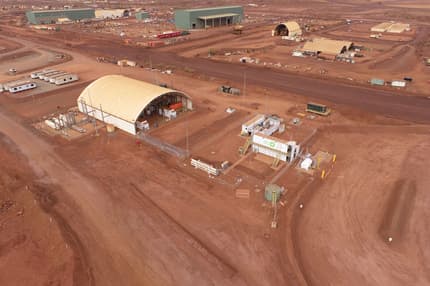A liquid hydrogen plant at Fortescue’s Christmas Creek mine site in Western Australia’s (WA) Pilbara has come online, as part of the iron ore major’s $50m Green Metal Project.

Designed, built and commissioned by New Zealand-based Fabrum, the liquefaction plant has around 350kg liquid hydrogen capacity per day and will supply Fortescue’s prototype mining equipment, including the recently delivered hydrogen-powered haul truck.
Hydrogen will be supplied to the liquefaction plant from a 530kg per day electrolyser plant, recently commissioned at the site, with some gaseous hydrogen set to be used to refuel a fleet of 10 fuel cell-powered coaches.
Powered “partly” by solar during the day, the hydrogen plant, fitted with two 700kW electrolysers, will supply two refuelling stations: gaseous and liquid, according to Fortescue.

© Fabrum
The plant’s commissioning comes as Fortescue said it had started to build the wider project which is expected to produce over 1,500 tonnes of green metal per year, with first production anticipated in 2025.
“This renewable hydrogen plant is versatile, enabling us to produce gaseous and liquid hydrogen to be used to power our mining equipment prototypes, while also providing the added benefit of refuelling our fleet of coaches at Christmas Creek,” said Dino Otranto, CEO of Fortescue Metals.
Fortescue’s Executive Chairman, Dr. Andrew Forrest, said the start of the works marked a “pivotal moment” in the company’s journey to build a green metal supply chain.
“Iron and steel are the backbone of our infrastructure, however, traditional iron and steel production processes are among the largest sources of greenhouse gas emissions.
“By rethinking the entire iron and steel value chain we can produce an entirely new, green industry here in Australia,” he said.
WA Premier Roger Cook, praised the plans, claiming the state was on track to becoming a “global clean energy powerhouse and a major producer, user and exporter of green iron.”
Last month Fortescue revealed 700 job cuts and pushed its target of producing 15 million tonnes of hydrogen per year by 2030, blaming high power prices for slowing progress.
Having been extremely vocal about the need for rapid, ambitious green hydrogen development, the company faced significant backlash for the decision, despite stressing it remained committed to the energy carrier.
Invite partners to see the activities of Pacific Group Co., Ltd.
FanPage: https://www.facebook.com/Pacific-Group
YouTube: https://www.youtube.com/@PacificGroupCoLt






